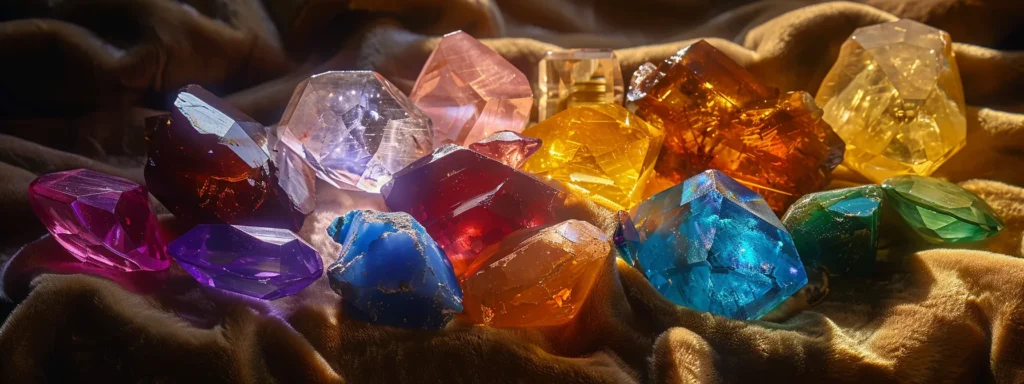Gemstones Therapy
Complete Guide to Birthstones and Their Significance
Table Of Contents:
- Key Takeaways
- Understanding Birthstones and Their Importance
- The History of Birthstones Through the Ages
- Modern vs. Traditional Birthstone Lists
- Birthstones by Month: A Comprehensive Guide
- Meanings and Symbolism of Each Birthstone
- Choosing the Perfect Birthstone Jewelry
- Caring for Your Birthstone
- Birthstones in Astrology and Zodiac Signs
- Cultural Significance Around the World
- Frequently Asked Questions About Birthstones
- Frequently Asked Questions
Have you ever wondered about the significance of your birthstone? Birthstones are gemstones associated with each month, believed to bring luck and protection to those born in that month. This guide will explore the history, meanings, and modern applications of birthstones, including popular gems like turquoise, opal, quartz, emerald, and peridot. We’ll cover how to choose and care for birthstone jewelry, their role in astrology, and their cultural importance worldwide. By the end of this article, you’ll have a comprehensive understanding of birthstones and their significance in various aspects of life.
Key Takeaways
- Birthstones are gemstones associated with specific months, symbolizing personal identity and cultural significance
- Each month has one or more birthstones, offering options for personalized jewelry and meaningful gifts
- Birthstones have historical origins and modern interpretations, with both traditional and contemporary lists available
- Proper care and maintenance of birthstone jewelry ensures its longevity and preserves its beauty over time
- Ethical sourcing considerations are increasingly important when selecting birthstones for jewelry purchases
Understanding Birthstones and Their Importance

Birthstones are gemstones associated with specific months, such as topaz, garnet, aquamarine, amethyst, and ruby. These precious stones hold cultural and personal significance, often reflecting an individual’s birth month and identity. Understanding birthstones involves exploring their historical origins and modern interpretations, as well as their role in personal adornment and symbolism.
What Are Birthstones
Birthstones are gemstones associated with specific months of the year, each carrying unique characteristics and significance. These precious stones have been cherished for centuries, with people often wearing their birthstone as jewelry, such as a necklace or ring, to connect with their birth month and personal identity.
Each month has one or more designated birthstones, ranging from the deep red garnet of January to the blue topaz of December. The concept of birthstones has evolved over time, with both traditional and modern lists existing, offering individuals a choice in selecting their preferred gemstone based on their birth month.
Birthstones hold cultural and symbolic meaning, often associated with specific qualities or attributes. Many people believe that wearing their birthstone can bring good fortune, protection, or enhance certain personality traits. This connection between gemstones and personal significance has made birthstones a popular choice for gift-giving and self-expression.
Significance in Personal Identity
Birthstones play a significant role in shaping personal identity, with many individuals choosing to wear their birthstone as a pendant or other jewelry. These gemstones, such as tourmaline or chrysoberyl, often serve as a tangible connection to one’s birth month and the qualities associated with it.
The unique characteristics of each birthstone, including tanzanite and onyx, can reflect aspects of an individual’s personality or desired traits. Wearing or displaying these stones allows people to express their individuality and connect with their personal history and cultural traditions.
Birthstones also serve as conversation starters, enabling individuals to share their birth month and the associated gemstone with others. This sharing of personal information can foster connections and create a sense of belonging within communities that value the tradition of birthstones.
The allure of birthstones runs deep. Their history stretches back through time, revealing a fascinating journey.
The History of Birthstones Through the Ages
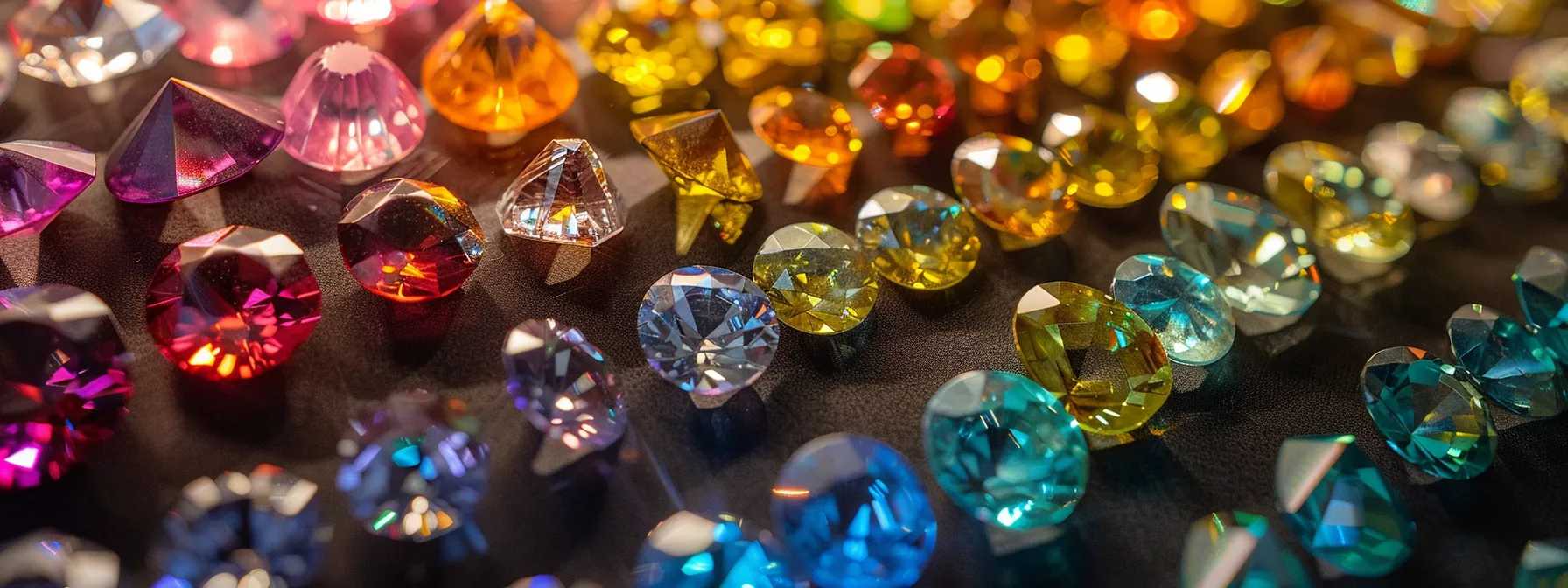
The history of birthstones spans millennia, rooted in ancient traditions and evolving over centuries. From their origins in zodiac lore to modern crystal interpretations, birthstones have transformed in meaning and selection. This section explores the ancient traditions behind birthstones and their evolution, including how minerals like zircon became popular for earrings and other jewelry.
Ancient Origins and Traditions
The concept of birthstones traces back to ancient civilizations, with roots in biblical and astrological traditions. The Breastplate of Aaron, described in the Book of Exodus, featured twelve gemstones representing the twelve tribes of Israel, which later became associated with the zodiac signs and months of the year.
Ancient cultures attributed mystical properties to gemstones, including moonstone and beryl. These stones were believed to possess healing powers and protective qualities, with their significance often tied to specific months or astrological signs. The practice of wearing birthstones for good fortune and spiritual connection evolved from these early beliefs.
Over time, different cultures developed their own birthstone traditions, incorporating various gemstones such as spinel and shades of blue sapphires. The modern birthstone list, standardized in 1912 by the National Association of Jewelers, includes both traditional and contemporary stones, offering options like carat weight variations to suit individual preferences and budgets.
Evolution Over Centuries
The evolution of birthstones over centuries reflects the changing cultural and religious influences on gemstone traditions. The ancient Israelites, for instance, used precious stones as amulets for protection and spiritual connection. This practice evolved into the use of specific gems for each month, with materials like lapis lazuli gaining popularity for their perceived mystical properties.
During the Middle Ages, birthstones became associated with the zodiac and the twelve apostles. This period saw the rise of silver as a popular setting for birthstones, making them more accessible to a wider population. The Latin-speaking scholars of this era contributed to the documentation and spread of birthstone lore across Europe.
The modern concept of birthstones emerged in the 18th century, with jewelers standardizing the list in 1912. This standardization marked a shift from traditional beliefs to a more commercialized approach, incorporating both ancient and newly discovered gemstones. The evolution of birthstones continues today, with alternative lists and the inclusion of synthetic stones to meet consumer demands:
Birthstones evolved. Modern lists differ from tradition.
Modern vs. Traditional Birthstone Lists

Modern and traditional birthstone lists differ in their gemstone selections and meanings. Changes over time reflect new discoveries and cultural shifts. The modern list includes stones like moissanite, while traditional lists feature corundum. These variations affect how birthstones are associated with months, such as December, and qualities like courage and happiness.
Differences Between Modern and Traditional Selections
Modern birthstone lists differ significantly from traditional selections, reflecting changes in gemstone availability and cultural preferences. While traditional lists often include stones like cabochon-cut gems, modern lists incorporate newly discovered or synthesized stones. This evolution has led to a broader range of options, allowing individuals to choose birthstones that resonate with their personal style and beliefs.
Traditional birthstone lists often draw from ancient myths and cultural wisdom, associating specific gemstones with virtues or protective qualities. In contrast, modern lists focus more on the aesthetic appeal and commercial availability of stones. For example, sterling silver jewelry featuring traditional birthstones might emphasize the stone’s mythical properties, while modern selections may prioritize color and durability.
The incorporation of alternative stones in modern lists has expanded the choices available for each birth month. This flexibility allows for greater personalization, with options ranging from traditional beads to contemporary cuts. While some purists prefer the historical significance of traditional selections, many appreciate the wider array of choices offered by modern lists, which can include both natural and lab-created gemstones.
Reasons Behind the Changes
The Gemological Institute of America (GIA) has played a significant role in updating birthstone lists, incorporating new scientific discoveries and gemological research. These changes reflect advancements in gem identification and classification, ensuring that birthstone selections align with modern gemological standards. The inclusion of the Feb birthstone, amethyst, in both traditional and modern lists demonstrates the enduring appeal of certain gems.
Changes in birthstone lists also stem from shifts in cultural preferences and jewelry trends. The traditional association with the Twelve Tribes of Israel has evolved to include a wider range of stones, accommodating diverse cultural backgrounds and personal tastes. This evolution has led to the inclusion of birthstone colors as a key factor in selection, allowing for greater flexibility in choosing gems that resonate with individual style preferences.
Market availability and affordability have influenced changes in birthstone lists. The introduction of bezel settings has made it easier to incorporate a variety of gemstones into jewelry, expanding options beyond traditional choices. This shift has democratized birthstone jewelry, making it accessible to a broader audience and contributing to the popularity of birthstone-themed accessories:
Tradition and modernity clash in the world of birthstones. Let’s explore each month’s gems, both old and new, to uncover their hidden stories.
Birthstones by Month: A Comprehensive Guide

This comprehensive guide explores birthstones for each month, from January’s garnet to December‘s turquoise, zircon, and tanzanite. It covers traditional and modern options, including the topaz birthstone for November and blue topaz for December. The guide also highlights birthstones associated with zodiac signs, such as Pisces and Scorpio, providing insight into their characteristics and significance.
January Birthstone — Garnet
Garnet, the birthstone for January, captivates with its deep red hue and rich symbolism. While garnet is the primary birthstone for this month, it’s worth noting that opal birthstone and sept birthstone also hold significance in other months’ birthstone traditions.
This versatile gemstone comes in various colors beyond red, including green, orange, and purple. Garnet‘s durability makes it suitable for everyday wear, much like the august birthstone peridot. Its fiery appearance symbolizes passion and vitality, aligning with the energy of the aries birthstone.
Garnet has been prized for centuries, with ancient Egyptians using it in jewelry and as a protective talisman. Its enduring popularity rivals that of the december birthstone, turquoise, in terms of historical significance. Garnet‘s affordability and availability make it an accessible choice for those seeking birthstone jewelry.
February Birthstone — Amethyst
Amethyst, the birthstone for February, exhibits a stunning purple hue that ranges from pale lavender to deep violet. This gemstone shares its royal color with the november birthstone, topaz, in its blue variety. Amethyst‘s association with clarity and spiritual insight makes it a popular choice for meditation and healing practices.
The durability of amethyst rivals that of the march birthstone, aquamarine, making it suitable for daily wear in various jewelry styles. Its affordability and abundance allow for larger, statement pieces that capture attention similar to the bold orange of the october birthstone, opal. Amethyst‘s versatility in jewelry design complements both casual and formal attire.
Throughout history, amethyst has been prized by royalty and religious leaders, much like the june birthstone, pearl, and the september birthstone, sapphire. Ancient Greeks believed amethyst could prevent intoxication, leading to its use in wine goblets. Today, amethyst remains a symbol of sobriety, peace, and tranquility, making it a thoughtful gift for February birthdays or as an alternative to traditional engagement rings.
March Birthstone — Aquamarine
Aquamarine, the March birthstone, captivates with its serene blue color reminiscent of clear ocean waters. This gem shares its association with calmness and clarity with the February birthstone, amethyst. Aquamarine‘s durability makes it an excellent choice for birthstone rings, offering both beauty and longevity.
The versatility of aquamarine allows for various cuts and settings, making it ideal for birthstone jewelry for mom. Its pale blue hue complements many skin tones and styles, offering a sophisticated alternative to the deep red of the January birthstone, garnet. Aquamarine‘s affordability compared to some other precious gems makes it accessible for creating stunning birthstone rings for mom.
Historically, aquamarine was believed to protect sailors and ensure safe voyages. This connection to water and tranquility makes it a thoughtful gift for those born in March or anyone seeking a sense of peace. Unlike birthstone rings that feature more common gems, aquamarine pieces often become cherished family heirlooms, passed down through generations.
April Birthstone — Diamond
Diamond, the April birthstone, stands as the most coveted gem for birthstone rings for women. Its unparalleled brilliance and durability make it a popular choice for custom birthstone rings, often surpassing the appeal of december birthstone jewelry. Diamonds symbolize eternal love and strength, making them ideal for engagement rings and special occasion gifts.
While traditionally colorless, diamonds come in various hues, allowing for diverse birthstone necklaces designs. Their versatility suits different jewelry styles, from classic solitaires to modern, multi-stone birthstone bracelets. The variety in diamond cuts and settings enables jewelers to create unique custom birthstone rings that cater to individual preferences.
Despite their association with April, diamonds feature prominently in birthstone jewelry for all months. Their timeless appeal and value retention make diamond birthstone necklaces and bracelets popular choices for milestone gifts. When selecting diamond birthstone jewelry, consider factors such as cut, clarity, and carat weight to ensure the best quality within one’s budget.
May Birthstone — Emerald
Emerald, the May birthstone, captivates with its rich green color and timeless elegance. This precious gemstone has adorned Real Gemstone Bracelets for centuries, symbolizing rebirth and renewal. The vibrant green hue of emeralds ranges from light to deep, with the most prized specimens displaying a vivid, saturated color.
The durability of emeralds makes them suitable for various jewelry pieces, including pendants and rings. However, their inclusion characteristics require careful handling and protective settings. When selecting an emerald for Real Gemstone Bracelets, buyers should consider the stone’s clarity, cut, and overall quality to ensure they acquire a valuable and beautiful piece.
Emeralds have a rich history, with ancient civilizations revering them for their supposed healing and protective properties. Today, these gemstones remain popular choices for May birthstone jewelry and as alternative engagement rings. The enduring appeal of emeralds in Real Gemstone Bracelets stems from their unique beauty and cultural significance:
June Birthstones — Pearl, Moonstone, and Alexandrite
June boasts three birthstones: pearl, moonstone, and alexandrite, each offering unique characteristics and symbolism. Pearls, organic gems formed within mollusks, represent purity and wisdom. Moonstones captivate with their adularescence, symbolizing new beginnings. Alexandrite, known for its color-changing properties, represents balance and joy.
Pearls come in various colors and shapes, with white being the most traditional. Their delicate nature requires special care, making them ideal for special occasion jewelry. Moonstones and alexandrite offer more durability for everyday wear, allowing June-born individuals to incorporate their birthstones into daily accessories.
The variety of June birthstones provides options for different preferences and budgets. From classic pearl strands to modern alexandrite rings, jewelers create diverse designs to suit various tastes. When selecting June birthstone jewelry, consider factors such as personal style, gemstone quality, and intended use to make an informed choice:
- Pearl: Classic elegance, requires gentle care
- Moonstone: Mystical appearance, suitable for daily wear
- Alexandrite: Rare and valuable, color-changing properties
July Birthstone — Ruby
Ruby, the birthstone for July, captivates with its vibrant red hue and rich symbolism. This precious gemstone ranks among the most valuable colored stones, prized for its durability and rarity. Rubies symbolize passion, courage, and prosperity, making them popular choices for both fine jewelry and engagement rings.
The quality of a ruby depends on several factors, including color, clarity, cut, and carat weight. The most desirable rubies exhibit a deep, vivid red color known as “pigeon’s blood.” Fine rubies often command higher prices per carat than diamonds of comparable size and quality, reflecting their rarity and desirability in the gem market.
Throughout history, rubies have held significant cultural and spiritual importance. Ancient cultures believed rubies possessed protective powers and could bring good fortune to their wearers. Today, rubies continue to be cherished for their beauty and symbolism, making them ideal gifts for July birthdays or 40th wedding anniversaries. When selecting ruby jewelry, consider the following factors:
- Color intensity and saturation
- Clarity and presence of inclusions
- Cut quality and overall symmetry
- Carat weight and size
- Origin, with Burmese rubies often commanding premium prices
August Birthstones — Peridot and Spinel
August boasts two birthstones: peridot and spinel, each offering unique characteristics and appeal. Peridot, known for its olive-green hue, symbolizes strength and vitality. Spinel, available in various colors, represents longevity and rejuvenation. These gemstones provide August-born individuals with diverse options for birthstone jewelry.
Peridot‘s distinctive color ranges from yellowish-green to olive, with the most prized specimens exhibiting a deep, rich green. This gemstone‘s durability makes it suitable for everyday wear in rings, pendants, and earrings. Spinel, often mistaken for other gemstones in the past, has gained recognition for its brilliance and range of colors, including red, pink, blue, and purple.
When selecting August birthstone jewelry, consider the following factors:
- Color intensity and saturation of the gemstone
- Clarity and presence of inclusions
- Cut quality and overall symmetry
- Carat weight and size
- Setting style and metal choice
September Birthstone — Sapphire
Sapphire, the birthstone for September, captivates with its deep blue hue and rich symbolism. This precious gemstone, a variety of corundum, ranks second only to diamond in hardness, making it an excellent choice for everyday wear. While blue is the most recognized color, sapphires occur in various hues, including pink, yellow, and green.
The quality of a sapphire depends on several factors, including color saturation, clarity, and cut. The most prized sapphires exhibit a vivid, velvety blue color known as “Kashmir” or “cornflower” blue. These gems often command premium prices due to their rarity and desirability. Sapphires with unique color-changing properties, such as those from Ceylon, offer an intriguing option for collectors and jewelry enthusiasts.
Throughout history, sapphires have held significant cultural and spiritual importance. Ancient cultures associated these gems with wisdom, loyalty, and nobility. Today, sapphires remain popular choices for engagement rings and fine jewelry, prized for their durability and timeless beauty. When selecting sapphire jewelry, buyers should consider factors such as color intensity, clarity, and origin to ensure they acquire a high-quality piece that will be cherished for generations.
October Birthstones — Opal and Tourmaline
October birthstones, opal and tourmaline, offer diverse options for those born in this month. Opal captivates with its play-of-color, displaying a rainbow of hues within a single stone. Tourmaline, known for its wide color range, provides versatility in jewelry design.
Opals require special care due to their delicate nature, making them ideal for occasional wear in pendants or earrings. Tourmaline‘s durability suits everyday use in rings and bracelets. Both gemstones symbolize creativity and emotional balance, appealing to those seeking meaningful jewelry.
When selecting October birthstone jewelry, buyers should consider the quality of the play-of-color in opals and the intensity of hue in tourmalines. Reputable jewelers can guide customers in choosing high-quality specimens that will retain their beauty and value over time.
November Birthstones — Topaz and Citrine
November birthstones, topaz and citrine, offer distinct characteristics and appeal. Topaz, known for its variety of colors, includes the popular blue topaz, often used in statement jewelry pieces. Citrine, with its warm yellow to orange hues, represents abundance and positivity, making it a sought-after gemstone for both jewelry and decorative purposes.
Topaz‘s durability makes it suitable for everyday wear in rings and pendants, while citrine’s affordability allows for larger, eye-catching designs. Both gemstones symbolize strength and clarity, resonating with those born in November. Jewelers often combine these stones in unique designs, creating versatile pieces that cater to different style preferences.
When selecting November birthstone jewelry, buyers should consider the color intensity and clarity of both topaz and citrine. Natural citrine is rare, with most commercial varieties being heat-treated amethyst. High-quality topaz and citrine pieces retain their value and beauty over time, making them excellent choices for both personal adornment and investment.
December Birthstones — Turquoise, Zircon, and Tanzanite
December boasts three birthstones: turquoise, zircon, and tanzanite, each offering unique characteristics and symbolism. Turquoise, known for its distinctive blue-green color, has been prized for millennia and symbolizes wisdom and tranquility. Zircon, available in various colors, is valued for its brilliance and fire, while tanzanite, with its striking blue-violet hue, represents transformation and spiritual awakening.
Turquoise‘s opaque, porous nature requires special care, making it ideal for occasional wear in pendants or earrings. Zircon and tanzanite offer greater durability, suitable for everyday use in rings and other jewelry. These gemstones provide December-born individuals with diverse options for birthstone jewelry, catering to different styles and preferences.
When selecting December birthstone jewelry, buyers should consider factors such as color intensity, clarity, and origin. The quality and rarity of these gemstones can significantly affect their value and appearance:
Each stone holds a story. Let’s uncover the meanings behind these ancient gems.
Meanings and Symbolism of Each Birthstone
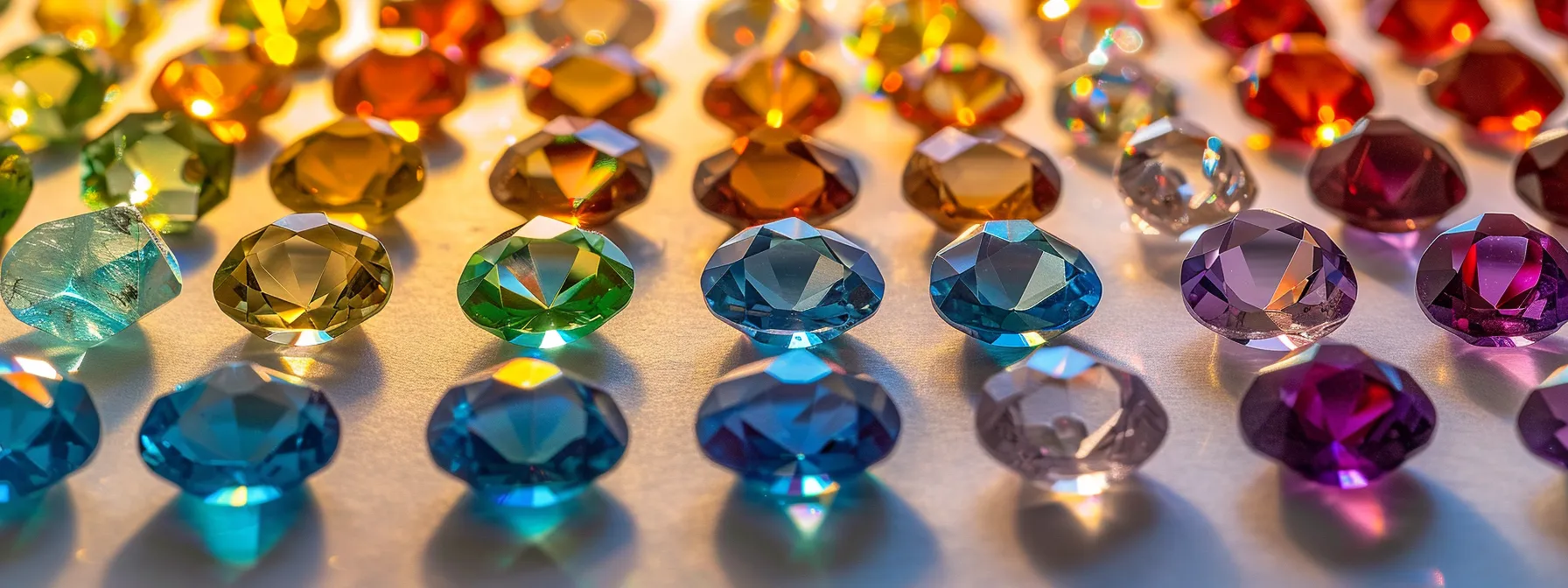
Birthstones carry deep meanings and symbolism, rooted in ancient traditions and modern interpretations. This section explores the emotional and spiritual associations of each birthstone, as well as their believed healing properties and benefits. Understanding these aspects provides insight into why birthstones remain significant in personal adornment and gift-giving traditions.
Emotional and Spiritual Associations
Birthstones carry deep emotional and spiritual significance, often reflecting the qualities and attributes associated with each month. Garnet, the January birthstone, symbolizes passion and vitality, while February’s amethyst represents clarity and spiritual insight. These associations provide individuals with a tangible connection to their birth month and personal identity.
The spiritual meanings of birthstones extend beyond individual months, encompassing broader themes of protection and well-being. Aquamarine, the March birthstone, is believed to promote calmness and clear communication, while April’s diamond symbolizes strength and eternal love. These emotional connections make birthstones popular choices for meaningful gifts and personal talismans.
Many people find comfort and inspiration in the emotional resonance of their birthstone. The May birthstone, emerald, is associated with growth and renewal, while June’s pearl represents purity and wisdom. By wearing or meditating with their birthstone, individuals often report feeling more connected to their inner selves and the natural world around them.
Healing Properties and Benefits
Birthstones are believed to possess healing properties that can benefit physical, emotional, and spiritual well-being. These gemstones are thought to resonate with specific energies that align with their corresponding birth months. For example, garnet, the January birthstone, is associated with boosting circulation and energy levels.
Many individuals use their birthstones in crystal healing practices, meditation, or as daily reminders of their personal goals. Amethyst, the February birthstone, is often used to promote calmness and clarity of mind. The healing properties attributed to birthstones vary widely, encompassing both physical and metaphysical benefits.
While scientific evidence for the healing properties of birthstones is limited, many people report positive experiences when working with these gemstones. The placebo effect and the power of belief may play a role in the perceived benefits. Some commonly attributed healing properties of birthstones include:
- Stress reduction and emotional balance
- Enhanced focus and mental clarity
- Improved physical vitality and energy
- Spiritual growth and self-awareness
- Protection from negative energies
Knowing the meanings behind birthstones adds depth to their beauty. Now, let’s explore how to select the perfect birthstone jewelry that speaks to you.
Choosing the Perfect Birthstone Jewelry

Selecting the perfect birthstone jewelry involves choosing ideal gemstones, customizing for personal meaning, and considering different jewelry types. This section guides readers through the process of selecting birthstones that resonate with their personal style and significance, while offering tips for various jewelry pieces to showcase these meaningful gems effectively.
Selecting the Ideal Gemstone
Selecting the ideal gemstone for birthstone jewelry requires careful consideration of several factors. The gem’s color, clarity, and cut significantly impact its overall appearance and value. Buyers should prioritize stones that exhibit vibrant, consistent color and minimal visible inclusions.
When choosing a birthstone, individuals should consider their personal style and intended use of the jewelry. Some gems, like diamonds and sapphires, offer exceptional durability suitable for daily wear, while others, such as opals, require more delicate handling. Consulting with a reputable jeweler can provide valuable insights into the quality and care requirements of specific gemstones.
Budget considerations play a crucial role in selecting the ideal birthstone. While some gems, like rubies and emeralds, command premium prices, alternatives such as garnets or peridots offer attractive options at more accessible price points. Buyers should balance their desire for a particular gemstone with their budget constraints to find the best value:
- Assess the gem’s color, clarity, and cut
- Consider personal style and intended use
- Evaluate durability for daily wear
- Balance desired gemstone with budget constraints
- Consult with a reputable jeweler for guidance
Customizing for Personal Meaning
Customizing birthstone jewelry allows individuals to create pieces with deep personal meaning. By incorporating multiple birthstones, such as those of family members or significant dates, one can design unique jewelry that tells a personal story. This customization extends beyond gemstone selection to include metal choices, engraving options, and setting styles.
Personalized birthstone jewelry often serves as meaningful gifts for special occasions. Mothers’ rings featuring children’s birthstones or family pendants with multiple gems are popular choices. These custom pieces not only celebrate important relationships but also become cherished heirlooms passed down through generations.
When customizing birthstone jewelry, consider the following factors to enhance personal significance:
Tips for Different Jewelry Types
When selecting birthstone rings, consider the wearer’s lifestyle and hand shape. Durable gemstones like diamonds or sapphires are ideal for everyday wear, while softer stones may be better suited for occasional use. For those with shorter fingers, elongated cuts such as oval or marquise can create an illusion of length.
Birthstone necklaces offer versatility in design and stone size. Pendant styles allow for larger, statement gemstones, while delicate chains with smaller birthstones provide a subtle, everyday look. For layering, choose complementary chain lengths and consider mixing birthstones with other meaningful symbols or initials.
Birthstone earrings require careful consideration of face shape and personal style. Studs offer classic simplicity suitable for all occasions, while drop earrings can add elegance to formal attire. When selecting hoop earrings with birthstones, ensure the gems are securely set to prevent loss during wear.
You’ve chosen your perfect birthstone jewelry. Now, let’s protect your gem’s beauty. Proper care ensures your birthstone shines for years to come.
Caring for Your Birthstone
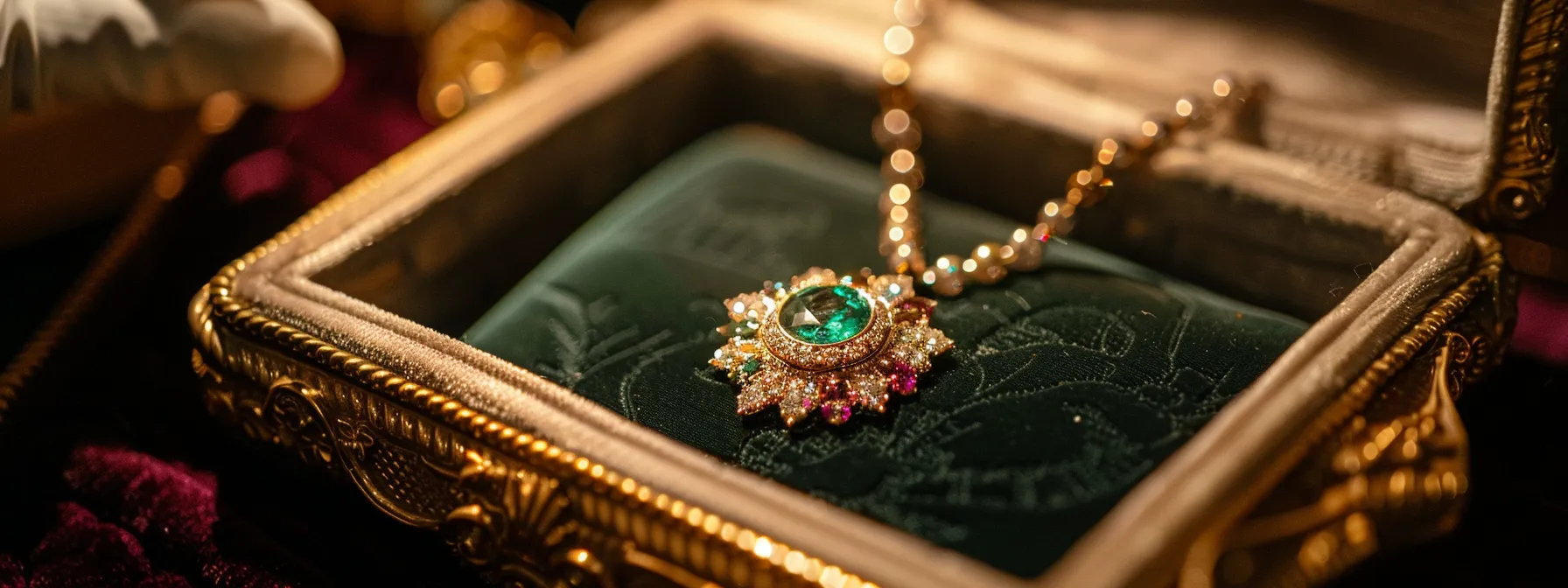
Proper care ensures the longevity and beauty of birthstone jewelry. This section covers effective cleaning methods for various gemstones and provides essential storage and maintenance tips. Understanding these practices helps preserve the brilliance and value of birthstones, ensuring they remain cherished pieces for years to come.
Proper Cleaning Methods
Proper cleaning methods for birthstones vary depending on the gemstone‘s hardness and composition. Soft stones like pearls and opals require gentle cleaning with a damp, lint-free cloth, while harder gems like diamonds and sapphires can withstand mild soap solutions. It’s essential to avoid harsh chemicals or ultrasonic cleaners, which can damage certain birthstones.
For most birthstones, a simple cleaning routine using warm water and a soft brush can effectively remove dirt and oils. After cleaning, gemstones should be thoroughly rinsed and dried with a clean, soft cloth to prevent water spots. Regular cleaning maintains the stone’s brilliance and allows for inspection of any potential damage or loose settings.
Professional cleaning by a qualified jeweler is recommended for valuable or delicate birthstone pieces. Jewelers have specialized equipment and expertise to safely clean and inspect gemstones without causing damage. They can also provide advice on specific care routines tailored to individual birthstones, ensuring long-lasting beauty and value.
Storage and Maintenance Tips
Proper storage of birthstone jewelry is crucial for maintaining its beauty and preventing damage. Storing pieces separately in soft cloth pouches or individual compartments prevents scratching and tangling. For delicate gems like pearls and opals, avoid airtight containers that can trap moisture and cause damage over time.
Regular maintenance checks help identify potential issues before they become serious problems. Inspect settings periodically for loose stones or worn prongs, especially in frequently worn pieces. Professional jewelers can perform thorough examinations and make necessary repairs to ensure the longevity of birthstone jewelry.
When not in use, store birthstone jewelry away from direct sunlight and extreme temperatures to prevent fading or structural changes in certain gems. Consider the following storage and maintenance tips for optimal care:
- Use soft, lined jewelry boxes or fabric pouches for storage
- Keep different gemstones separate to prevent scratching
- Remove jewelry before engaging in household chores or physical activities
- Schedule annual professional cleanings and inspections
- Restring pearl necklaces every few years to prevent breakage
Birthstones hold power beyond their beauty. Let’s explore their connection to astrology and zodiac signs.
Birthstones in Astrology and Zodiac Signs

Birthstones in astrology and zodiac signs play a significant role in personal identity and spiritual practices. This section explores the connections between birthstones and zodiac traditions, highlighting how these gems align with astrological beliefs. It also examines how birthstones can enhance personal traits associated with specific zodiac signs, offering insights into their use in self-improvement and personal growth.
Connections With Zodiac Traditions
The connection between birthstones and zodiac traditions dates back centuries, with each zodiac sign associated with specific gemstones. These associations draw on ancient astrological beliefs, linking the energies of celestial bodies to the properties of earthly gems. Astrologers often recommend wearing or carrying the corresponding birthstone to enhance the positive traits of one’s zodiac sign.
In Western astrology, the twelve zodiac signs align with particular months and their associated birthstones. For example, the fiery nature of Aries (March 21 – April 19) resonates with the strength and passion symbolized by diamonds, the April birthstone. This alignment is believed to amplify the natural characteristics of individuals born under each sign.
Many people incorporate their zodiac birthstones into daily life, wearing them as jewelry or using them in meditation practices. The belief is that these gems can help balance energies, mitigate challenges associated with one’s astrological sign, and enhance personal growth. While scientific evidence is lacking, many find comfort and inspiration in this ancient tradition of connecting celestial influences with earthly treasures.
Enhancing Personal Traits
Birthstones associated with zodiac signs are believed to enhance personal traits and characteristics. Individuals often choose to wear or carry their zodiac birthstone to amplify positive attributes and mitigate challenges associated with their astrological sign. For example, those born under Leo might wear peridot to boost confidence and creativity.
The practice of using birthstones to enhance personal traits extends beyond mere adornment. Many people incorporate these gemstones into meditation practices or place them in living spaces to create a harmonious environment aligned with their astrological energies. This intentional use of birthstones is thought to support personal growth and self-improvement efforts.
While scientific evidence for the effectiveness of birthstones in enhancing personal traits is limited, many individuals report positive experiences. The psychological impact of wearing or using a birthstone associated with one’s zodiac sign can lead to increased self-awareness and confidence. This effect may stem from the placebo effect or the power of belief, highlighting the importance of personal connection to these astrological traditions:
- Aries: Diamond for courage and strength
- Taurus: Emerald for growth and patience
- Gemini: Pearl for communication and adaptability
- Cancer: Ruby for emotional balance and intuition
- Leo: Peridot for confidence and creativity
- Virgo: Sapphire for wisdom and purity
- Libra: Opal for harmony and justice
- Scorpio: Topaz for transformation and passion
- Sagittarius: Turquoise for optimism and honesty
- Capricorn: Garnet for success and commitment
- Aquarius: Amethyst for innovation and humanitarianism
- Pisces: Aquamarine for intuition and empathy
Birthstones bridge the gap between astrology and global cultures. Their significance spans continents, shaping traditions and beliefs worldwide.
Cultural Significance Around the World
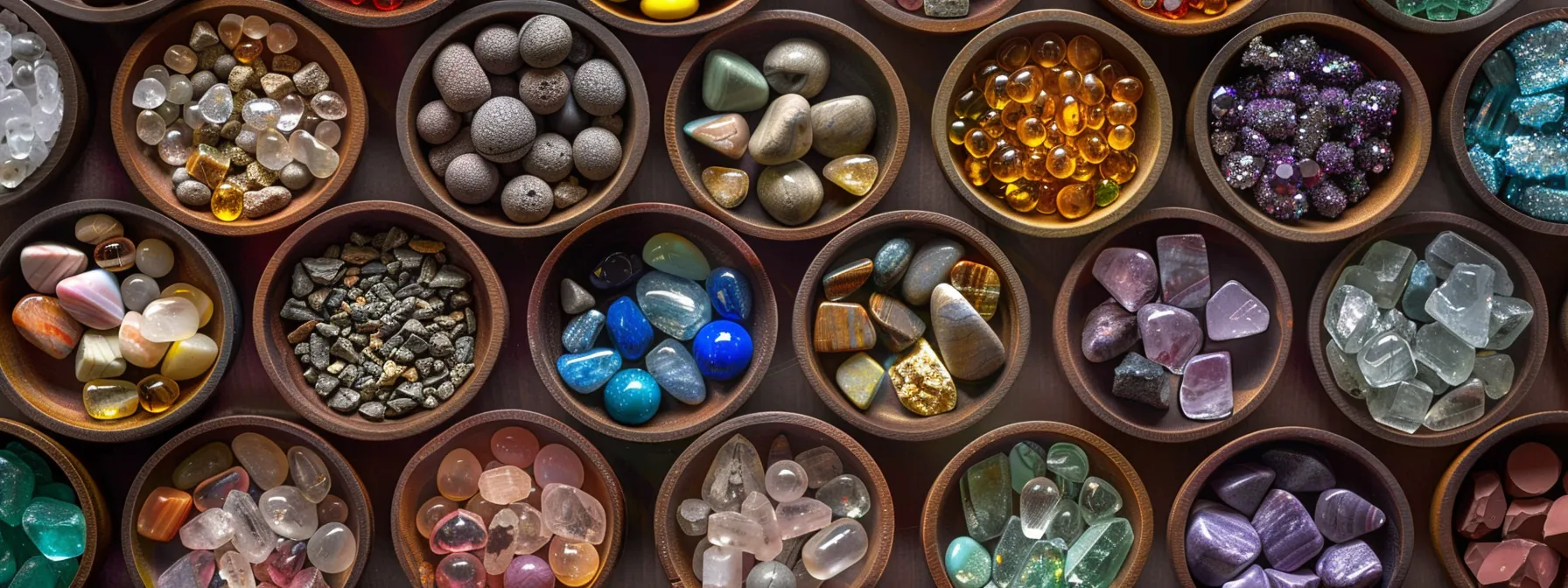
Birthstones hold diverse cultural significance worldwide, reflecting unique traditions and beliefs. This section explores birthstone customs in various cultures, highlighting global differences in gemstone assignments. Understanding these cultural variations provides insight into the universal appeal of birthstones and their role in personal adornment and spiritual practices across different societies.
Birthstone Traditions in Various Cultures
Birthstone traditions vary significantly across cultures, reflecting diverse beliefs and historical contexts. In India, the practice of wearing navratna, or nine gems, is deeply rooted in Vedic astrology. Each gem corresponds to a celestial body and is believed to harness its beneficial energies, influencing the wearer’s life and fortune.
Chinese culture associates birthstones with the lunar calendar and the 12 animals of the zodiac. These gemstones are thought to bring luck and protection to individuals born in specific years. For instance, those born in the Year of the Rabbit might wear jade to enhance their natural characteristics and ward off negative influences.
In ancient Hebrew tradition, birthstones were linked to the twelve tribes of Israel and the breastplate of Aaron. This connection between gemstones and spiritual significance has influenced Western birthstone traditions, contributing to the modern list of monthly birthstones adopted by jewelers worldwide. The cultural diversity in birthstone practices highlights the universal human desire to find personal meaning in natural treasures.
Global Differences in Birthstone Assignments
Birthstone assignments vary significantly across different cultures and regions, reflecting diverse traditions and beliefs. In Western countries, the modern birthstone list standardized by the American National Association of Jewelers in 1912 is widely recognized. However, many cultures maintain their own unique birthstone traditions, often based on historical, astrological, or religious significance.
Asian countries, particularly India and China, have distinct birthstone systems rooted in ancient practices. The Indian Navaratna tradition associates nine gemstones with celestial bodies, while Chinese astrology links birthstones to the lunar calendar and zodiac animals. These cultural differences result in varied gemstone assignments for the same birth months or zodiac signs across different regions.
Some cultures assign birthstones based on factors beyond birth month, such as day of the week or astrological sign. For example, Tibetan tradition associates specific gems with birth years in a 12-year cycle, while some European countries maintain older birthstone lists that differ from the modern American standard. These global variations highlight the rich cultural diversity surrounding birthstone traditions and offer individuals multiple options for personal connection to gemstones.
Birthstones captivate people worldwide. Let’s explore common questions about these gems.
Frequently Asked Questions About Birthstones
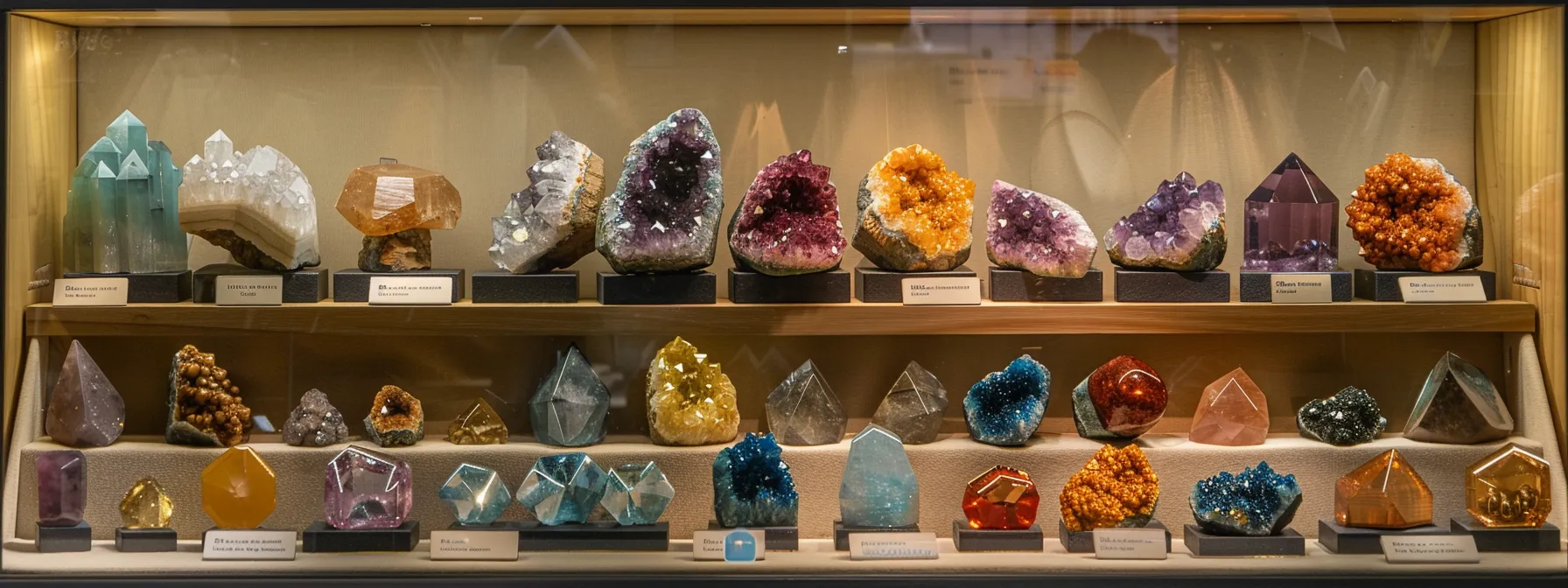
This section addresses common questions about birthstones, including wearing stones from other months, distinguishing between synthetic and natural gems, and ethical sourcing considerations. These topics provide practical insights for those interested in birthstone jewelry, offering guidance on selection, authenticity, and responsible purchasing practices.
Wearing Birthstones of Other Months
Wearing birthstones from other months is a common practice and is generally considered acceptable. Many individuals choose to wear gemstones associated with different months due to personal preference, aesthetic appeal, or symbolic meaning. This flexibility allows people to explore a wider range of gemstones and create unique jewelry combinations.
While traditional beliefs suggest wearing one’s own birthstone for maximum benefit, modern interpretations are more lenient. Some people opt to wear birthstones of loved ones as a way to feel connected to them or to commemorate special relationships. Others may choose gemstones based on their perceived properties or energies, regardless of birth month association.
When selecting birthstones from other months, consider the following factors:
- Personal attraction to the gemstone‘s color or properties
- Compatibility with existing jewelry or wardrobe
- Symbolic meaning or cultural significance
- Durability for intended use (e.g., daily wear vs. special occasions)
- Budget considerations and availability
Distinguishing Synthetic and Natural Stones
Distinguishing between synthetic and natural birthstones requires careful examination and often professional expertise. Natural stones typically exhibit slight imperfections or inclusions, while synthetic stones may appear flawless. The color and internal structure of natural gems often show subtle variations, whereas synthetic stones tend to have more uniform characteristics.
Gemologists use specialized equipment to identify synthetic stones, such as microscopes and spectroscopes. These tools help detect growth patterns, chemical compositions, and optical properties unique to synthetic gems. For consumers, purchasing from reputable jewelers and requesting certification can provide assurance of a stone’s origin.
While synthetic stones offer affordability and consistent quality, natural birthstones are often preferred for their rarity and inherent value. When choosing between synthetic and natural birthstones, consider the following factors:
- Budget constraints and personal preferences
- Intended use of the jewelry (daily wear vs. special occasions)
- Ethical considerations in gem sourcing
- Desire for unique, one-of-a-kind stones
- Importance of certification and provenance
Ethical Considerations in Sourcing
Ethical sourcing of birthstones has become increasingly important in the jewelry industry. Consumers are now more aware of the environmental and social impacts of gemstone mining, leading to a demand for responsibly sourced stones. Reputable jewelers often provide information on the origin and ethical standards of their gemstones, allowing buyers to make informed decisions.
Certifications and initiatives, such as the Kimberley Process for diamonds and Fairtrade gemstones, help ensure ethical practices in the supply chain. These programs aim to eliminate conflict stones and promote fair labor conditions in mining communities. Buyers can look for these certifications when purchasing birthstone jewelry to support responsible sourcing practices.
Synthetic and lab-grown birthstones offer an ethical alternative to mined gems, reducing environmental impact and eliminating concerns about labor practices. These stones possess the same chemical and physical properties as their natural counterparts, providing a sustainable option for environmentally conscious consumers. When considering birthstone jewelry, buyers should weigh the ethical implications of their purchase alongside traditional factors like appearance and cost.
Frequently Asked Questions
What is the difference between modern and traditional birthstone lists?
Modern and traditional birthstone lists differ in their origins and gemstone selections. Traditional lists, dating back centuries, were based on cultural and religious beliefs. Modern lists, established in 1912 by jewelers, incorporate a wider range of gemstones and are more commercially oriented. The gemstones assigned to each month can vary between the two lists. For example, the traditional birthstone for March is bloodstone, while the modern list features aquamarine. Some months have different options in the modern list, providing more choices for consumers and reflecting changes in gemstone availability and popularity.
How do I choose the right birthstone jewelry for myself or as a gift?
Choosing the right birthstone jewelry starts with identifying the recipient’s birth month. Each month has a corresponding gemstone, such as diamonds for April or emeralds for May. Consider the wearer’s personal style, preferred metal type, and the occasion when selecting a piece. For gifts, factor in the recipient’s taste and lifestyle. Necklaces, earrings, or rings are popular choices. If buying for yourself, try on different styles to see what complements your wardrobe and skin tone. Remember, quality and durability are important factors when investing in birthstone jewelry.
Are birthstones connected to astrology and zodiac signs?
Birthstones and astrology have some connections, but they are not directly linked to zodiac signs. While both systems assign gemstones to specific time periods, birthstones are typically associated with calendar months, whereas astrological stones are tied to planetary influences and celestial bodies. The modern birthstone list, standardized in 1912, is based on tradition, gemstone availability, and marketing efforts by jewelers. Astrology, on the other hand, uses a different set of gemstones that are believed to enhance the energies of particular zodiac signs and planets, focusing on their metaphysical properties.
How can I properly care for and maintain my birthstone jewelry?
Proper care for birthstone jewelry involves gentle cleaning with mild soap and warm water, using a soft brush for intricate details. Avoid harsh chemicals, ultrasonic cleaners, and extreme temperatures. Store pieces separately in soft cloth pouches to prevent scratches and tarnishing. Regular professional inspections can identify loose settings or worn prongs. Remove jewelry before swimming, exercising, or applying lotions. Different birthstones may require specific care, so research your particular gem’s needs. With proper maintenance, your birthstone jewelry will retain its beauty for years.
What cultural significance do birthstones have in different parts of the world?
Birthstones hold cultural significance in various parts of the world, often symbolizing luck, protection, and personal attributes. In Western cultures, they’re associated with birth months and zodiac signs, while in Eastern traditions, they’re linked to days of the week or specific life events. In India, birthstones are connected to planetary influences and used in Ayurvedic healing practices. Some African cultures view certain gemstones as tribal symbols or sources of spiritual power. These diverse cultural interpretations reflect the enduring global fascination with gemstones and their perceived mystical properties.



